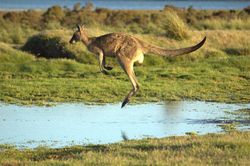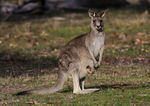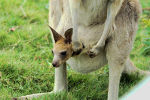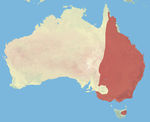Eastern grey kangaroo
| Eastern grey kangaroo |
|---|

|
| Scientific Classification |
|
| Binomial Name |
|
Macropus giganteus |
| Subspecies |
|
| Eastern grey kangaroo jumping over the lake |
The Eastern grey kangaroo is a species of kangaroo known by the scientific name Macropus giganteus. They are perhaps best known as the second largest marsupial in the world.[2] Kangaroo got their name from the Aboriginal word gangurru, which describes the Grey Kangaroo. The eastern grey kangaroo gathers in mob, and they’re found in Australia as well as New Guinea. There are more Kangaroos than Humans in Australia. They are the national symbol of Australia so they appear on postage stamps, coins, and even airplanes.[3]
Body Design
The eastern grey kangaroos are recognized by their long tails, powerful back legs, very big feet, stubby fur and long pointed ears. The females have pouches that can carry the baby, until they are old enough to take care of themselves.[4]
The grey eastern kangaroos are the only big sized animals that hop mainly for locomotion (movement or the ability to move from one place to another). On land they only move their hind legs together to hop, however When they are in water they kick each leg independently to swim.Their stretchy hind legs and their feet are much stronger and larger than their arms.[5]
When they’re eating, the eastern grey kangaroos moves around at a slow and steady pace, and for that they use their powerful tail as a “fifth leg” which pushes their body off the ground as they move slowly along. Kangaroos have a long muscular tail, it’s used to balance themselves when they are moving around. Eastern grey kangaroo have large ears, so they have excellent hearing. They are also excellent jumpers too.[4][6]
Life Cycle
The eastern grey kangaroo can live up to 15 to 20 years old. Despite this fact, some people say that they usually live around 23 years. Eastern grey kangaroos breeding may occur all year round, but they usually give birth in the summer, which is between September and March.[2] A new born baby kangaroo is born at an early stage of development, after a pregnancy of just thirty six days. A joey (a baby kangaroo,) weighs less than one gram when it is born. After the joey is born, it immediately climbs into the mother’s pouch. There it feeds itself it’s mother’s milk, and undergoes the rest of its development.[4] Joeys of eastern grey kangaroos develop much slower than other kangaroo species. After approximately 283 days living in their mother’s pouch, that’s when they appear from the mother kangaroos pouch. They appear once in a while when food is available the most. They finally leave the pouch completely approximately after 320 days. The joey weans when it’s about 18 months old. Many female kangaroos are able to become pregnant again very soon, even after giving birth.[7]As the baby joey grows bigger, their head and feet can be often seen hanging out of the mother’s pouch.[3]
Ecology
The grey eastern kangaroos are large marsupials that can be only found in Australia. [6] The eastern grey kangaroos are herbivores, that eats grasses, flowers, leaves, ferns, mosses and sometimes even insects. Kangaroos also regurgitate their food and re-chew it before it is ready to be totally digested, which is similar to how cows digest.[7] The eastern grey kangaroos are social animals that lives in groups called mobs, herds or troops. A mob of Eastern grey kangaroo will groom each other and protect each other from predators or anything that might harm them. If one of the kangaroo members suspects there is a predator nearby the area, it will stomp its large foot on the ground to warn the others that their is something dangerous nearby. If the kangaroo has to attack, it will then start to box and kick its predator/opponent. [5] The kangaroos rest in the shade in the afternoon. When the weather is extremely hot, they dig holes and sleep in the soil to cool them down.
Warning and Communication
Kangaroos are smart animals, when they escape from dangerous predators they kick them with their powerful front feet, then they use this chance to escape. Most kangaroos that live in the natural habitat or in the zoo eat grass everyday as their main menu. Their diet consists mainly of grass; they can survive a long period of time without water. Many mobs of kangaroos will graze together on the grassland. When they are feeding the joey, they move along with all four feet on the ground. Their tail supports them when they are grazing, and it also helps them balance when they are hopping.[2]
The male eastern grey kangaroos often 'box' or show other types of aggressive acts to establish dominance. The most powerful male is more likely to mate with a female when they’re in estrus (a recurring period of sexual receptivity and fertility in many female mammals; heat). When a female eastern grey kangaroo reaches estrus, the male will come towards the female kangaroo and sniff various parts of her body, including her pouch and urogenital area. He may also make clucking noises and paw her head and her tail, a behavior characteristic of many kangaroo species. [3]
Both male and female eastern grey kangaroos often communicate with each other and their joey, by making clucking noises. When they’re alarmed, they give out a guttural cough. This cough is also heard when males warn each other, or when they fight, or when they want to show power over each other. All grey kangaroos stamp their hind legs on the ground when they sense danger around them. When the kangaroos stamp their foot, or make the guttural (throaty) noise, that warning can travel a far distance.[5][3]
Video
The eastern grey kangaroo jumping.
References
- ↑ 1.0 1.1 Macropus giganteus Wikispecies. Web. Last modified on January 11, 2015. Author Unknown.
- ↑ 2.0 2.1 2.2 EasternGreyKangarooFact lowryparkzoo. Web. accessed on January 27, 2015 Author Unknown.
- ↑ 3.0 3.1 3.2 3.3 Poke, Darren. InterestingFactsAbout EasternGreyKangaroos haydensanimalfacts. Web. Date Last modified on January 26, 2015.
- ↑ 4.0 4.1 4.2 Eastern Grey Kangaroo arkive. Web. Date accessed January 14, 2015 Author Unknown.
- ↑ 5.0 5.1 5.2 Bradford, Alina. Kangaroo Facts livescience. Web. Date of publication October 15, 2014.
- ↑ 6.0 6.1 Burrell, Sue. Eastern Grey Kangaroo australianmuseum. Web. Last Updated March 3, 2014.
- ↑ 7.0 7.1 Macropus giganteus reptilepark. Web. accessed on January 27, 2015 Author Unknown.




